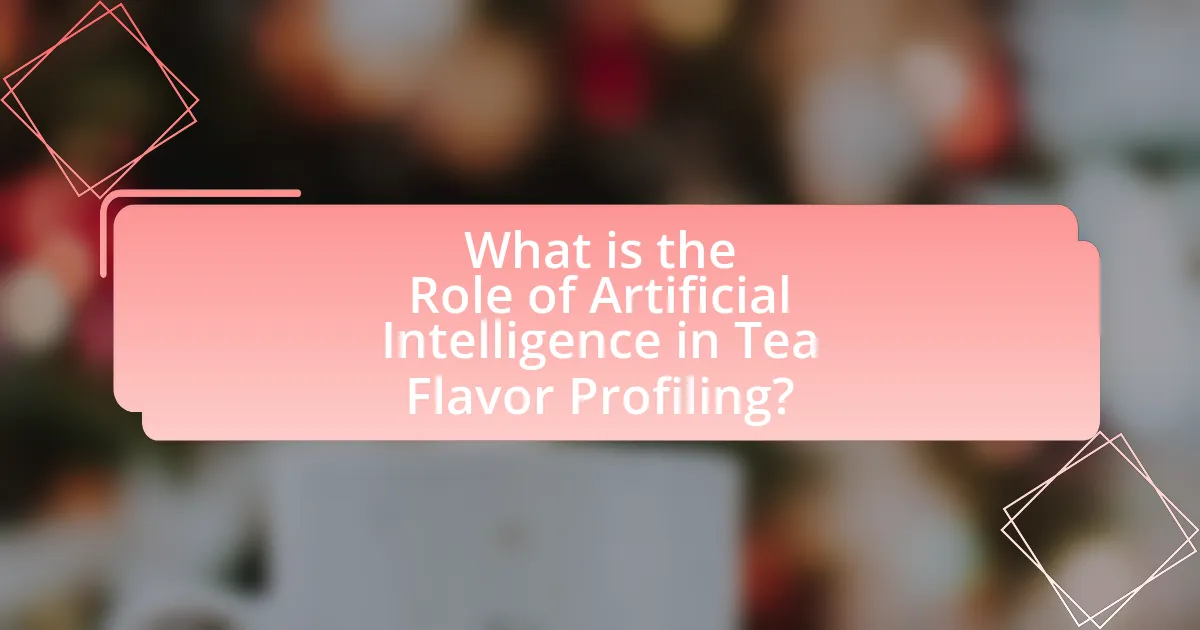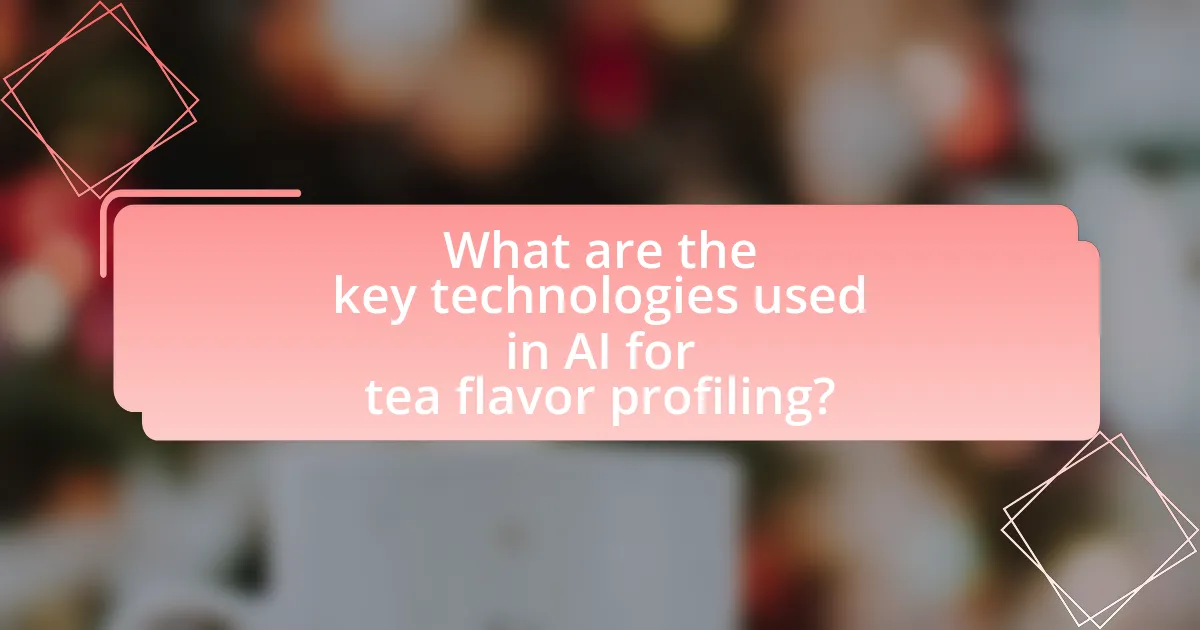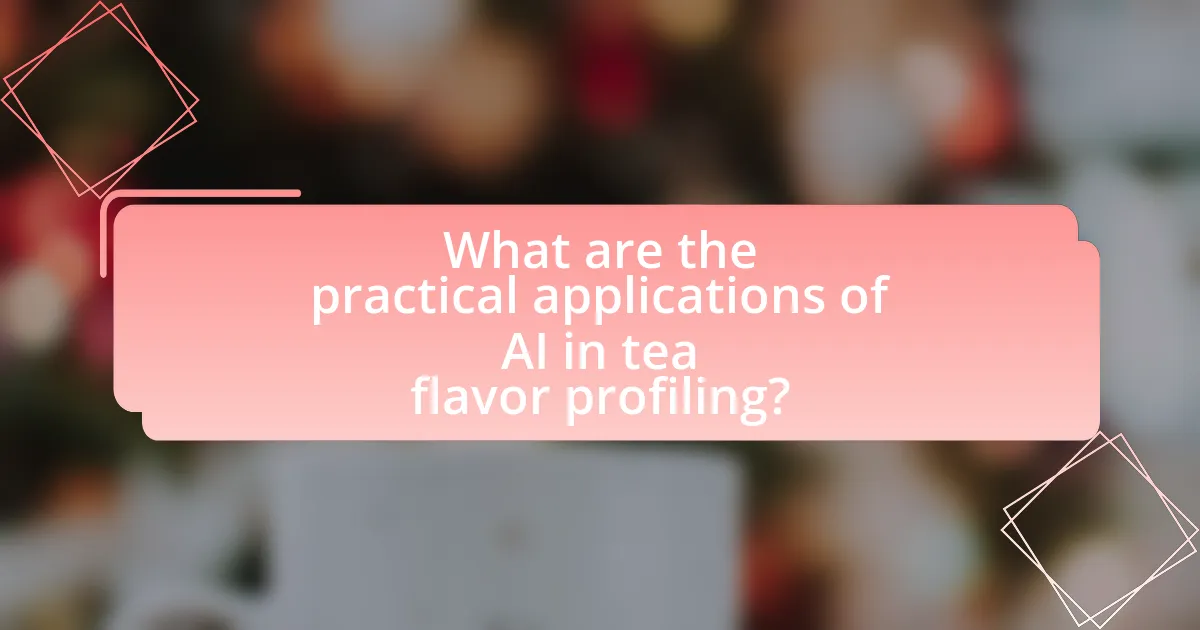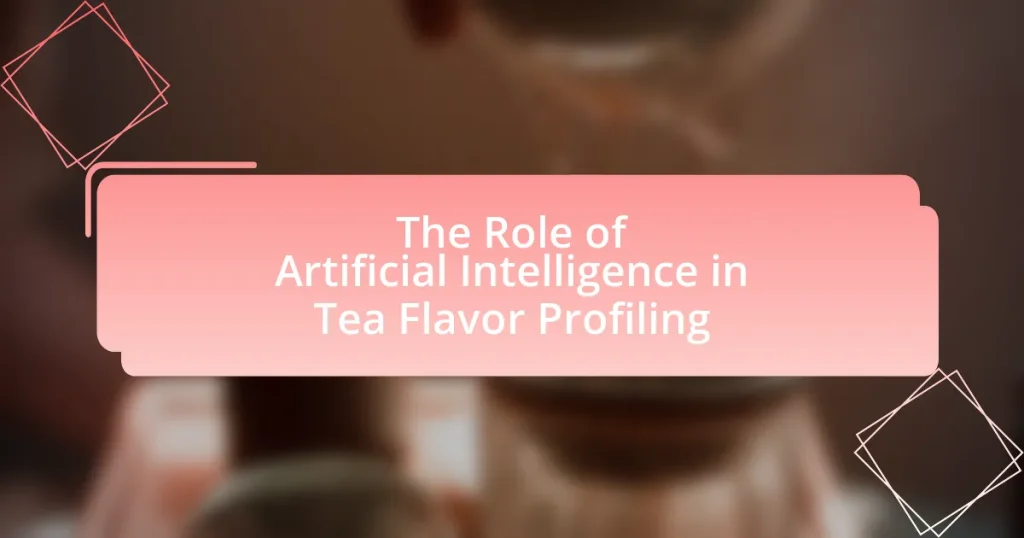The article focuses on the role of Artificial Intelligence (AI) in tea flavor profiling, highlighting how AI analyzes complex flavor compounds and predicts consumer preferences through machine learning algorithms. It discusses the techniques employed by AI, such as sensory analysis and natural language processing, to enhance flavor understanding and classification. The article also compares AI-driven methods to traditional flavor profiling, emphasizing the increased accuracy and efficiency AI brings to the tea industry. Additionally, it explores the impact of flavor profiling on consumer preferences, production, and marketing strategies, while outlining the key technologies and future trends in AI applications within the tea sector.

What is the Role of Artificial Intelligence in Tea Flavor Profiling?
Artificial Intelligence plays a crucial role in tea flavor profiling by analyzing complex flavor compounds and predicting consumer preferences. AI algorithms, particularly machine learning models, can process vast datasets of chemical compositions and sensory evaluations to identify patterns that define specific tea flavors. For instance, research has shown that AI can accurately classify tea types based on their volatile compounds, enhancing the precision of flavor profiling. This capability allows producers to tailor their products to meet market demands, ultimately improving quality and consumer satisfaction.
How does Artificial Intelligence contribute to understanding tea flavors?
Artificial Intelligence contributes to understanding tea flavors by analyzing chemical compounds and sensory data to create flavor profiles. Machine learning algorithms can process large datasets from tea samples, identifying patterns and correlations between specific compounds and flavor characteristics. For instance, research has shown that AI can predict flavor profiles based on the presence of certain polyphenols and amino acids, which are critical in determining taste and aroma. This data-driven approach enhances the ability to classify and recommend teas based on individual preferences, leading to a more personalized tea experience.
What techniques does AI use to analyze tea flavor profiles?
AI employs techniques such as machine learning, sensory analysis, and natural language processing to analyze tea flavor profiles. Machine learning algorithms can identify patterns in large datasets of flavor compounds and consumer preferences, enabling the prediction of flavor characteristics based on chemical composition. Sensory analysis, often enhanced by AI, involves the systematic evaluation of tea samples using trained panels or consumer feedback, which AI can analyze to correlate sensory attributes with chemical data. Natural language processing allows AI to analyze reviews and descriptions of tea, extracting insights about flavor perceptions and preferences. These techniques collectively enhance the understanding of tea flavor profiles by integrating quantitative chemical data with qualitative sensory experiences.
How does AI compare to traditional methods of flavor profiling?
AI significantly enhances flavor profiling compared to traditional methods by utilizing advanced algorithms and data analysis techniques. Traditional flavor profiling often relies on sensory evaluation by trained tasters, which can be subjective and inconsistent. In contrast, AI employs machine learning models that analyze large datasets of chemical compounds and sensory attributes, leading to more objective and reproducible results. For instance, a study published in the journal “Food Chemistry” demonstrated that AI could predict flavor profiles with over 90% accuracy by analyzing chemical data, whereas traditional methods typically achieve lower consistency rates. This ability to process vast amounts of data quickly allows AI to identify flavor patterns and correlations that human tasters may overlook, ultimately improving the precision and efficiency of flavor profiling in tea.
Why is flavor profiling important in the tea industry?
Flavor profiling is important in the tea industry because it enables producers to identify and categorize the unique taste characteristics of different tea varieties. This process enhances product consistency and quality, allowing manufacturers to meet consumer preferences more effectively. For instance, flavor profiling helps in distinguishing between subtle notes in teas, such as floral, fruity, or earthy flavors, which can significantly influence consumer choice. Additionally, research indicates that flavor profiling can lead to improved marketing strategies, as brands can tailor their offerings based on specific flavor profiles that resonate with target demographics.
What impact does flavor profiling have on consumer preferences?
Flavor profiling significantly influences consumer preferences by aligning product offerings with individual taste inclinations. This alignment enhances customer satisfaction and loyalty, as consumers are more likely to choose products that match their flavor profiles. Research indicates that personalized flavor recommendations can increase purchase likelihood by up to 30%, demonstrating the effectiveness of flavor profiling in catering to specific consumer tastes. By utilizing data analytics and machine learning, companies can identify and predict flavor trends, further refining their product development to meet evolving consumer demands.
How does flavor profiling influence tea production and marketing?
Flavor profiling significantly influences tea production and marketing by enabling producers to tailor their products to consumer preferences. This process involves analyzing the sensory attributes of tea, such as aroma, taste, and mouthfeel, which helps in identifying specific flavor profiles that appeal to target markets. For instance, research indicates that consumers increasingly prefer teas with unique flavor combinations, prompting producers to innovate and create blends that align with these preferences. Additionally, flavor profiling aids in quality control, ensuring consistency in taste, which is crucial for brand loyalty and market positioning. By leveraging data analytics and artificial intelligence, tea companies can predict trends and adjust their marketing strategies accordingly, enhancing their competitive edge in the industry.

What are the key technologies used in AI for tea flavor profiling?
The key technologies used in AI for tea flavor profiling include machine learning algorithms, sensory analysis, and data analytics. Machine learning algorithms, such as support vector machines and neural networks, analyze complex datasets to identify flavor patterns and preferences. Sensory analysis employs techniques like gas chromatography and mass spectrometry to quantify volatile compounds in tea, providing data that AI models can interpret. Data analytics tools process large volumes of consumer feedback and tasting notes, enabling AI systems to refine flavor profiles based on real-world preferences. These technologies collectively enhance the accuracy and efficiency of flavor profiling in the tea industry.
How do machine learning algorithms enhance flavor analysis?
Machine learning algorithms enhance flavor analysis by enabling the identification and quantification of complex flavor compounds in tea. These algorithms analyze large datasets of chemical compositions and sensory evaluations, allowing for the detection of patterns and correlations that human analysts may overlook. For instance, a study published in the journal “Food Chemistry” demonstrated that machine learning models could accurately predict flavor profiles based on chemical data, achieving over 90% accuracy in classification tasks. This capability not only streamlines the flavor profiling process but also improves the consistency and quality of tea products by providing precise recommendations for blending and processing.
What types of data are used in machine learning for flavor profiling?
Machine learning for flavor profiling utilizes various types of data, including chemical composition data, sensory evaluation data, and consumer preference data. Chemical composition data involves the analysis of compounds such as polyphenols, amino acids, and volatile compounds found in tea, which can be quantified using techniques like gas chromatography and mass spectrometry. Sensory evaluation data is gathered through expert panels or consumer tastings, where attributes like aroma, taste, and mouthfeel are rated. Consumer preference data is collected through surveys and market analysis, revealing trends and preferences among different demographics. These data types collectively enable machine learning algorithms to identify patterns and predict flavor profiles effectively.
How do neural networks contribute to flavor prediction?
Neural networks contribute to flavor prediction by analyzing complex patterns in chemical compounds and sensory data associated with flavors. They utilize deep learning algorithms to process large datasets, enabling the identification of relationships between specific compounds and perceived flavors. For instance, a study published in the journal “Food Chemistry” demonstrated that neural networks could accurately predict flavor profiles based on the chemical composition of tea, achieving over 90% accuracy in flavor classification. This capability allows for more precise flavor profiling and the development of new tea blends tailored to consumer preferences.
What role does sensory analysis play in AI-driven flavor profiling?
Sensory analysis is crucial in AI-driven flavor profiling as it provides the foundational data that AI algorithms use to understand and predict flavor characteristics. By systematically evaluating the sensory attributes of tea, such as aroma, taste, and mouthfeel, sensory analysis generates quantitative and qualitative data that can be fed into machine learning models. This data allows AI to identify patterns and correlations between sensory attributes and consumer preferences, enhancing the accuracy of flavor profiling. For instance, studies have shown that integrating sensory data with AI can improve the prediction of flavor profiles by up to 30%, demonstrating the effectiveness of this approach in developing tailored tea products.
How can AI integrate sensory data with chemical analysis?
AI can integrate sensory data with chemical analysis by utilizing machine learning algorithms to correlate sensory attributes, such as taste and aroma, with chemical compounds identified through analytical techniques like gas chromatography and mass spectrometry. This integration allows for the development of predictive models that can identify flavor profiles based on chemical composition. For instance, studies have shown that AI can analyze large datasets from sensory evaluations and chemical analyses to uncover patterns that link specific compounds to perceived flavors, enhancing the understanding of tea flavor profiling.
What are the challenges of combining sensory analysis with AI?
The challenges of combining sensory analysis with AI include the difficulty in quantifying subjective sensory experiences and the need for large, high-quality datasets to train AI models effectively. Sensory analysis relies heavily on human perception, which is inherently subjective and varies between individuals, making it challenging to create standardized metrics for AI algorithms. Additionally, AI systems require extensive training data to recognize patterns and make predictions, but obtaining consistent and reliable sensory data can be resource-intensive and time-consuming. For instance, a study published in the journal “Food Quality and Preference” highlights that discrepancies in sensory evaluations can lead to inconsistent AI model outputs, emphasizing the importance of robust data collection methods.

What are the practical applications of AI in tea flavor profiling?
AI is applied in tea flavor profiling primarily for enhancing flavor prediction, optimizing blending processes, and personalizing consumer experiences. By utilizing machine learning algorithms, AI analyzes chemical compositions and sensory data to predict flavor profiles with high accuracy. For instance, AI systems can process data from gas chromatography and mass spectrometry to identify volatile compounds that contribute to specific flavors, enabling producers to create blends that meet consumer preferences. Additionally, AI-driven recommendation systems can suggest tea varieties based on individual taste profiles, improving customer satisfaction and engagement. These applications demonstrate AI’s capability to transform tea flavor profiling into a more precise and consumer-oriented process.
How can tea producers benefit from AI flavor profiling?
Tea producers can benefit from AI flavor profiling by enhancing the precision of flavor development and improving product consistency. AI algorithms analyze vast datasets of flavor compounds and consumer preferences, enabling producers to identify optimal flavor combinations and predict market trends. For instance, a study by the University of California demonstrated that machine learning models could accurately predict flavor profiles based on chemical composition, leading to more targeted cultivation and processing methods. This data-driven approach not only increases efficiency but also helps producers meet consumer demands more effectively, ultimately driving sales and customer satisfaction.
What specific improvements can AI bring to tea quality control?
AI can significantly enhance tea quality control by enabling precise monitoring and analysis of various factors affecting tea production. Through machine learning algorithms, AI can analyze data from environmental conditions, such as temperature and humidity, to predict optimal harvesting times, thereby ensuring better flavor profiles. Additionally, AI-powered image recognition can assess leaf quality and detect defects, allowing for immediate corrective actions. Research indicates that AI applications in agriculture can improve yield quality by up to 20%, demonstrating its effectiveness in maintaining high standards in tea production.
How does AI assist in developing new tea blends?
AI assists in developing new tea blends by analyzing vast datasets of flavor profiles, consumer preferences, and chemical compositions of tea ingredients. This technology utilizes machine learning algorithms to identify patterns and correlations that human experts may overlook, enabling the creation of unique blends tailored to specific tastes. For instance, AI can predict how different tea varieties will interact based on their chemical compounds, leading to innovative combinations that enhance flavor and aroma. Studies have shown that AI-driven approaches can significantly reduce the time and cost associated with traditional blending methods, making the process more efficient and responsive to market trends.
What are the future trends in AI and tea flavor profiling?
Future trends in AI and tea flavor profiling include the integration of machine learning algorithms to analyze consumer preferences and enhance flavor prediction accuracy. As AI technology advances, it will enable more precise identification of flavor compounds through techniques like gas chromatography-mass spectrometry, allowing for a deeper understanding of the chemical profiles of different tea varieties. Additionally, AI-driven sensory analysis tools will likely emerge, utilizing neural networks to correlate flavor attributes with consumer feedback, thereby personalizing tea recommendations. This trend is supported by the growing body of research indicating that AI can significantly improve flavor profiling accuracy and consumer satisfaction in the beverage industry.
How might advancements in AI technology change flavor profiling?
Advancements in AI technology will enhance flavor profiling by enabling more precise and personalized flavor analysis. Machine learning algorithms can analyze vast datasets of flavor compounds and consumer preferences, leading to the identification of complex flavor profiles that traditional methods may overlook. For instance, AI can utilize sensory data and chemical analysis to predict how different tea blends will taste, allowing producers to tailor products to specific consumer tastes. Research has shown that AI can improve flavor prediction accuracy by up to 30%, demonstrating its potential to revolutionize the tea industry by creating unique blends that cater to individual preferences.
What potential innovations could emerge in the tea industry through AI?
AI could drive innovations in the tea industry by enhancing flavor profiling, optimizing cultivation practices, and improving supply chain efficiency. For instance, machine learning algorithms can analyze chemical compounds in tea leaves to create precise flavor profiles, enabling producers to tailor blends to consumer preferences. Additionally, AI can predict optimal growing conditions and pest management strategies, leading to higher yields and better quality tea. Research from the University of California, Davis, highlights how AI-driven analytics can streamline logistics, reducing waste and ensuring fresher products reach consumers. These advancements demonstrate AI’s potential to transform the tea industry significantly.
What best practices should tea producers follow when implementing AI for flavor profiling?
Tea producers should prioritize data quality, model selection, and continuous learning when implementing AI for flavor profiling. High-quality data, including chemical compositions and sensory evaluations, is essential for training accurate AI models. Producers should select appropriate machine learning algorithms that can effectively analyze complex flavor profiles, such as neural networks or decision trees. Additionally, continuous learning and model refinement based on new data and consumer feedback will enhance the AI’s predictive capabilities, ensuring that flavor profiling remains relevant and accurate over time. These practices are supported by studies indicating that robust data and adaptive algorithms significantly improve the accuracy of flavor predictions in food and beverage industries.


